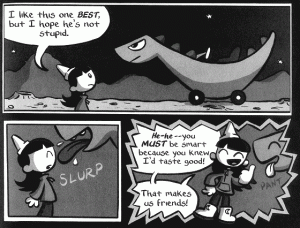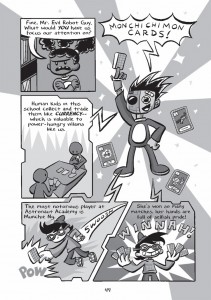Welcome to Using Graphic Novels in Education, an ongoing feature from CBLDF that is designed to allay confusion around the content of graphic novels and to help parents and teachers raise readers. In this column, we examine graphic novels, including those that have been targeted by censors, and provide teaching and discussion suggestions for the use of such books in classrooms.
This post takes a closer look at Astronaut Academy series by Dave Roman.
“I guess sometimes it takes seeing people OUT OF THE USUAL CONTEXT or gravity before you can realize HOW INTERESTING they can be.” — Dave Roman, Astronaut Academy.
Astronaut Academy is a two-volume series about friendship, rivalries, diversity, teamwork, growing up, and the pleasures and pains of boarding school — in space. It is chalk-full of dinosaur cars, robots, magical elves, pandas, bunnies sports, love, bold statements, puns, cuteness, and evil. His story centers around life at a futuristic boarding school in space, and Roman packs so many references to both kid and adult movies, books, and games that these books, while geared for grades 4-8, can be enjoyed by kids of all ages.
Astronaut Academy is a two-book series. Book 1, Zero Gravity, introduces us to Astronaut Academy’s characters and their backgrounds. Through their individual voices we learn about each of them. We are shown glimpses of their pasts along with hints of a strange creature who’s hiding somewhere in the school and feeding off of human emotions. This book is really an introduction to the second book, which carries most of the story. Book 2, Re-Entry, is all about how Astronaut Academy’s diverse students, with their rivalries and passions, work together as they grow, mature, and overcome the human-emotion-feeding monster. Books 1 and 2 originally began as a webcomic, later to be published as a two-volume story by First Second Books. While the first book feels like a comic strip, the second feels more like a graphic novel. Astronaut Academy is a New York Public Library Book for Reading and Sharing, a Graphic Novel Reporter Best Graphic Novel of the Year, and a Maryland Black-Eyed Susan Award.
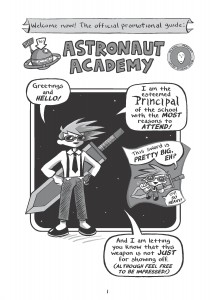 What makes these books empowering and loads of fun is Roman’s wonderful sense of humor and the way he playfully incorporates concepts of diversity and special needs, along with some powerful all-ages messages on the perils of rivalry and the power of friendship and teamwork. The playfulness in this series is achieved through Roman’s wonderful puns and wordplay as well as his rendering of his characters and their school. His use of graytones adds a fun, funky retro feel while his sharp angles and name choices add a manga feel.
What makes these books empowering and loads of fun is Roman’s wonderful sense of humor and the way he playfully incorporates concepts of diversity and special needs, along with some powerful all-ages messages on the perils of rivalry and the power of friendship and teamwork. The playfulness in this series is achieved through Roman’s wonderful puns and wordplay as well as his rendering of his characters and their school. His use of graytones adds a fun, funky retro feel while his sharp angles and name choices add a manga feel.
Roman’s uncanny use of design has enabled him to draw a huge cast of characters in such a way that each is unique and adds to the depth of the story. Roman’s cast of characters includes bunnies, elves, robots, humans, bears, and cyborgs each with their own distinct personalities, passions and quirks. So for example, Hakata Soy, a mysterious hero with a somewhat dark past, wears a high collared jacket (hiding a part of him) and has spiked angled, wild hair, giving him a sharp James Dean type of feel. Senior Panda, on the other hand is one tough teacher/undercover IBW (Intergalactic Bureau of Wellbeing) agent who happens to look like a cuddly, furry panda. Another aspect of entertainment comes from Roman’s hidden references to all things kid-like and fun. There are references to Pokemon, My Neighbor Totoro, THX 1138, Harry Potter, A Wrinkle in Time, Sweeny Todd, Star Wars, Back to the Future, Pinocchio, Dark Side of the Moon, Super Mario World, Transformers, and many, many others.
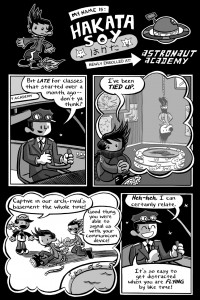 Throughout these two volumes, Roman subtly and not so subtly — but always with humor — shows and tells readers:
Throughout these two volumes, Roman subtly and not so subtly — but always with humor — shows and tells readers:
- That people are are different. There are no “average” teachers, students, heroes or villains and so we shouldn’t jump to conclusions about them. Instead, we need to discover and appreciate them.
- That growing up is all about learning to fight for oneself, although working as a team is even more powerful.
- That there are all kinds of love, and that friendships and relationships mean sharing your heart.
- That labels can’t define who we are on the inside, and sometimes not even what we are on the outside.
- That heroes come in all sizes, shapes and forms.
SERIES SUMMARY
 Astronaut Academy: Zero Gravity begins with Astronaut Academy’s “official promotional guide.” The remaining ‘chapters’ are about events unfolding at Astronaut Academy as told by its diverse students and teachers. This book contains a very large cast of characters. Thanks to Roman’s skill as a writer and artist, he makes it easy for us to keep track of them. Each chapter is told through the voice of one of these characters as they introduce themselves and tell us bits about their lives at the Academy along with hints of their past. This book started as a webcomic and as a result, it has a comic strip feel. While we eventually learn that Senior Panda is actually an undercover agent who believes there is a human emotion-eating monster at the Academy, the story truly unfolds in the second book.
Astronaut Academy: Zero Gravity begins with Astronaut Academy’s “official promotional guide.” The remaining ‘chapters’ are about events unfolding at Astronaut Academy as told by its diverse students and teachers. This book contains a very large cast of characters. Thanks to Roman’s skill as a writer and artist, he makes it easy for us to keep track of them. Each chapter is told through the voice of one of these characters as they introduce themselves and tell us bits about their lives at the Academy along with hints of their past. This book started as a webcomic and as a result, it has a comic strip feel. While we eventually learn that Senior Panda is actually an undercover agent who believes there is a human emotion-eating monster at the Academy, the story truly unfolds in the second book.
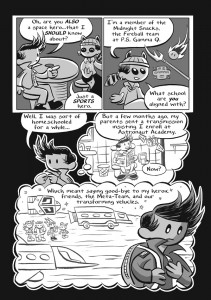 Astronaut Academy: Re-Entry begins after the semester break. In this volume, students return to find that there is “BEARed up security.” Security bears are making sure students are safe from the human-emotion-feeding monster who feeds on students’ hearts. The school goes into lockdown mode as parents and school administrators ban any forms of love (in the fear that students will be tricked to share their hearts with the heart-eating monster). In the end, though, it is the students who are the true heroes and together save the day, save love, and save the school.
Astronaut Academy: Re-Entry begins after the semester break. In this volume, students return to find that there is “BEARed up security.” Security bears are making sure students are safe from the human-emotion-feeding monster who feeds on students’ hearts. The school goes into lockdown mode as parents and school administrators ban any forms of love (in the fear that students will be tricked to share their hearts with the heart-eating monster). In the end, though, it is the students who are the true heroes and together save the day, save love, and save the school.
While the first book is more comic-strip-like and the second more graphic novel and story-like, together, they offer a unique opportunity to observe the different forms telling one story by one author. It also offers a wonderful opportunity for studying character voices and character development.
TEACHING/DISCUSSION SUGGESTIONS:
Plot, Themes, and Values Related
- The books’ chapters are divided into different characters’ portrayal of events or friends. There is, however, very little character description. We learn about them by what they do, by what they don’t do, and by how they speak to us as they tell the story. You may want to break students into groups and have each group analyze a different character making sure they provide evidence from the book to support their analyses.
- As each character tells the story from his or her perspective, plot the themes as told by these diverse characters. Discuss how they’re similar and different, and why.
- Discuss and evaluate how different students perceive and address similar conflicts. Make sure students can support their opinions.
- Discuss and evaluate how the school culture at Astronaut Academy is similar and different to your own school/classroom culture.
- Throughout both books, there is a great deal rivalry and teamwork. Chart and evaluate these different rivalries as well as the different forms and means of teamwork. Discuss and evaluate the power rivalry and teamwork plays as these characters grow.
Critical Reading and Making Inferences
- The book begins with an “official guide” to Astronaut Academy. What can we learn about the school from its brochure? You may want to discuss what your class might put into their own official guide to your school or classroom.
- In Astronaut Academy: Zero Gravity, Mirabelle Mellonbelly says, “I like to blame Miyumi San because she is my arch rival. But accusations do nothing to fill the EMPTY SPOT by my side.” Discuss what Mirabelle means. Discuss how accusations may make us feel better initially, but don’t always help us in the long run.
- Discuss and evaluate what Roman means when he writes In Astronaut Academy: Zero Gravity that, “I guess sometimes it takes seeing people OUT OF THE USUAL CONTEXT or gravity before you realize how INTERESTING they can be.” (p. 134).
- Discuss and evaluate what Roman means when he writes In Astronaut Academy Re-Entry that, “Suddenly I knew if I kept letting my past weigh me down I could expect only to sink. If I wanted an AWESOME FUTURE, I needed to keep the focus on things I could be positive about.”
Language, Literature, and Language Usage
- Have students describe each of the characters in these books and how Roman enables us to differentiate each character’s “voice.”
- Search, discuss, and evaluate Dave Roman’s wonderful wordplay throughout these books. Here are some of my favorites:
- Zero Gravity:
- p. 11: “It’s so easy to get distracted when you are flying by like time!”
- p. 28: “I know his name is HAKATA SOY but not much else because he has reserved the right to remain RESERVED. Which is QUITE like Quiet.”
- p. 42: “All the people of Hoppiton marched toward their aggressors. Only to end up BURNED by the flames of defeat, which can scorch…”
- p. 63: “She was MEAN in ways that felt MEANINGFUL… or at least MEANT something to ME.”
- p. 90: “My parents were hardly the BEES KNEES But a hard worker can overcome class struggle.”
- p. 112: “DETAINMENT. Is that like detention plus entertainment?”
- Zero Gravity:
- Re-Entry:
- p. 25: “Things sure are different this semester. And I mean the BEAR-ed up security” (said as they are facing two armed “Security Bears”).
- p. 38: “I plan to keep both my hearts in tact not in TAK!”
- p. 65: “The Library… But you gotta be careful in any place with that many books—interesting characters could be lurking around every corner.”
- p. 66: “Like the infinite sprawl of the galaxy, so, too, is the written language EVER EXPANDING.”
- p. 69: “Hop with your SOUL as well as your SOLES.”
- pp. 185-187: “It is easy to focus on how cold and lonely a SPACE the galaxy can be. But with the transformative power of old and new friends combined… I feel as though I am just getting WARMED UP!”
- Astronaut Academy is full of humor. Have students search and evaluate different examples of his humor from his puns to his wordplay. For example, in Zero Gravity p. 41 Roman writes, “Anybody know how to use a gun? NO WAY! Those things are dangerous! I’ve got a butter knife!”
- Astronaut Academy is full of metaphors and similes. Have students search and evaluate different examples of each.
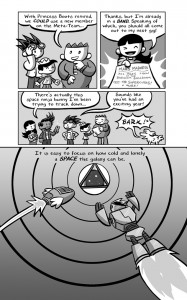 Modes of Storytelling and Visual Literacy
Modes of Storytelling and Visual Literacy
In graphic novels, images are used to relay messages with and without accompanying text, adding additional dimension to the story. In Astronaut Academy Roman weaves story and background through text, image and design. Reading Astronaut Academy with your students allows you to analyze, discuss and learn how Dave Roman uses page and panels, text and images to relay complex messages. For example:
- Mr. Roman relies on text and image to distinguish between a diverse and large cast of characters. Have students evaluate how he visually distinguishes between these characters (in terms of facial expressions, clothing, hair, etc.).
- Discuss Mr. Roman’s use of balloon design to help tell the story. Analyze the text balloon shapes, sizes, and designs are used to relay different character moods.
- Mr. Roman also plays a lot with the borders of his panels. Discuss why certain panel formats change when they change, and evaluate what this is trying to tell the reader.
- The book begins with an “official guide” to Astronaut Academy. What can we learn about the school from its brochure? You may want to discuss what images your students might include in their own official guides to your school or classroom, and why. You may also want to discuss how these images might be arranged to help continue to show off your school/classroom culture.
- Mr. Roman intentionally writes words all in upper-case while most of his words are mixed upper and lower-case. Chart and discuss how his decision to relay particular words all in upper case letters helps relay the story.
- In these books Mr. Roman provides both visual and verbal puns. Search for the visual puns and discuss how they add to the story. (For example in Zero Gravity, p. 63 he writes “Ever since I got a crush from a girl in my rocket science class…” and we see she has literally crushed him with a rocket.)
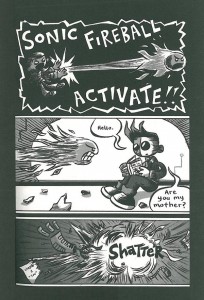 Suggested Prose, Graphic Novel and Poetry Pairings
Suggested Prose, Graphic Novel and Poetry Pairings
For greater discussion on literary style, related themes, similar characters and/or content here are some book suggestions you may want to read and pair with Astronaut Academy:
- Teen Boat by Dave Roman and John Green — about a teen who can transform himself into a small yacht. This book is all about the angst of being a teen coupled with the thrill of being a boat.
- Beanworld by Larry Marder — a graphic novel series that also began as web comics that deals a lot with diversity, team work, and building community.
- Bone by Jeff Smith — a different series (and one Roman quotes as influencing his work) of engaging characters that reflect the wisdoms and peculiarities of life’s challenges
- Amulet series by Kazu Kabuishi — about how a brother and sister who, through extenuating circumstances, find themselves battling for their freedome on a parallel world as they face mounting dangers with new friends.
- A Wrinkle in Time by Madeleine L’Engle — a book in which a brother and sister must travel to an alternate world to find and rescue their scientist father.
- The Harry Potter series by JK Rowling — coming-of-age series with magic, adventure, good, and evil.
Common Core State Standards (CCSS):
While this book is suggested for elementary and junior high school classrooms, it can be incorporated into language arts and content-area classes for a variety of grades. I therefore will be using the Common Core Anchor Standards for College and Career Readiness for Reading, Writing, and Speaking and Listening. Reading Astronaut Academy and incorporating the teaching suggestions above promotes critical thinking and its graphic novel format provides verbal and visual story telling across subject areas while addressing multi-modal teaching. Here’s a more detailed look:
- Knowledge of Language: Apply knowledge of language to understand how language functions in different contexts, to make effective choices for meaning or style, to comprehend more fully when reading or listening.
- Vocabulary Acquisition and Use: Determine or clarify the meaning of unknown and multiple-meaning words and phrases by using context clues, analyzing meaningful word parts, and consulting general and specialized reference materials; demonstrate understanding of figurative language, word relationships, and nuances in word meaning; acquire and use accurately a range of general academic and domain-specific words and phrases sufficient for reading, writing, speaking and listening at the college and career readiness level.
- Key ideas and details: Reading closely to determine what the texts says explicitly and making logical inferences from it; citing specific textual evidence when writing or speaking to support conclusions drawn from the text; determining central ideas or themes and analyzing their development; summarizing the key supporting details and ideas; analyzing how and why individuals, events, or ideas develop and interact over the course of the text.
- Craft and structure: Interpreting words and phrases as they are used in a text, including determining technical, connotative, and figurative meanings and analyzing how specific word choices shape meaning or tone; analyzing the structure of texts, including how specific sentences, paragraphs and larger portions of the text relate to each other and the whole; Assessing how point of view or purpose shapes the content and style of a text.
- Integration of knowledge and ideas: Integrate and evaluate content presented in diverse media and formats, including visually…as well as in words; delineate and evaluate the argument and specific claims in a text, including the validity of the reasoning as well as the relevance and sufficiency of the evidence; analyze how two or more texts address similar themes or topics in order to build knowledge or to compare the approaches the authors take
- Range of reading and level of text complexity: Read and comprehend complex literary and informational texts independently and proficiently
- Comprehension and collaboration: Prepare for and participate effectively in a range of conversations and collaborations with diverse partners, building on others’ ideas and expressing their own clearly and persuasively; integrate and evaluate information presented in diverse media and formats, including visually, quantitatively and orally; evaluate a speaker’s point of view, reasoning, and use of evidence and rhetoric.
ADDITIONAL RESOURCES:
- Learn all about Astronaut Academy’s students, faculty, and rivalries at: http://www.astronautacademy.com/about/`
- Astronaut Academy: Zero Gravity YouTube book trailer for the first book: https://www.youtube.com/watch?v=4ttXcINVvAk
- Astronaut Academy: Re-Entry YouTube book trailer for the second book: https://www.youtube.com/watch?v=Ilb0_hZ49aE
- For a preview of the second book: http://blogs.slj.com/goodcomicsforkids/2013/05/01/preview-astronaut-academy-re-entry/
- Discussion Guide for Astronaut Academy from First Second Books: http://images.macmillan.com/folio-assets/discusion-guides/9781596436206DG.pdf
Meryl Jaffe, PhD teaches visual literacy and critical reading at Johns Hopkins University Center for Talented Youth Online Division and is the author of Raising a Reader! and Using Content-Area Graphic Texts for Learning. She used to encourage the “classics” to the exclusion comics, but with her kids’ intervention, Meryl has become an avid graphic novel fan. She now incorporates them in her work, believing that the educational process must reflect the imagination and intellectual flexibility it hopes to nurture. In this monthly feature, Meryl and CBLDF hope to empower educators and encourage an ongoing dialogue promoting kids’ right to read while utilizing the rich educational opportunities graphic novels have to offer. Please continue the dialogue with your own comments, teaching, reading, or discussion ideas at meryl.jaffe@cbldf.org and please visit Dr. Jaffe at http://www.departingthe text.blogspot.com.
We need your help to keep fighting for the right to read! Help support CBLDF’s important First Amendment work by visiting the Rewards Zone, making a donation, or becoming a member of CBLDF!
All images (c) Dave Roman.


